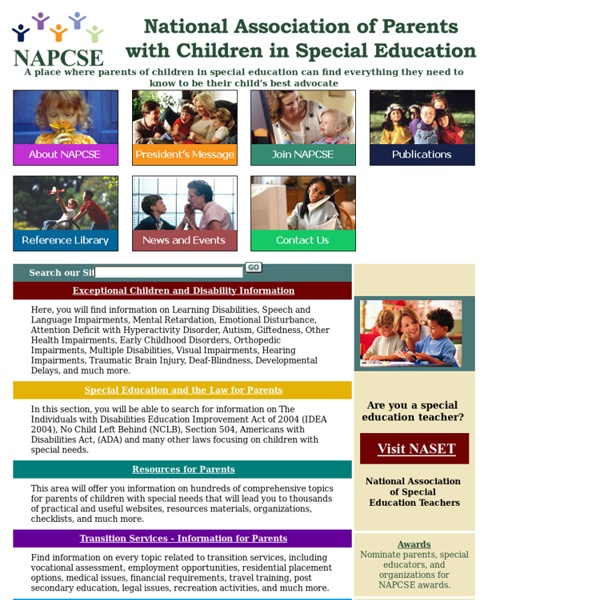



ADE Special Education | Home 30 Ideas for Teaching Children with Attention-Deficit/Hyperactivity Disorder by Leah Davies, M.Ed. By Leah Davies, M.Ed. The following list may assist teachers who work with ADHD students. For an overview of this disorder see, "Attention-Deficit/Hyperactivity Disorder in Children." 1. Understand the struggle a student with ADHD has and provide an ordered, safe, predictable classroom environment. 2. 3. 4. 5. 6. 7. 8. 9. 10. 11. 12. 13. 14. 15. 16. 17. 18. 19. 20. 21. 22. 23. 24. 25. 26. 27. 28. 29. 30. inShare
National Association of Parents with Children in Special Education SERI - Special Education Resources on the Internet Apps in Education Math, English programs, games, worksheets for grades K-8 - Dositey.com educational site Enjoy a wide range of lessons, practice exercises, step-by-step tutorials, and printable worksheets... Try today: Grades K-2: Phonics, Adding Same Numbers, Beginning Fractions Grades 3-4: Thousands, Order of Operations Grades 5-8: Reading, Naming, and Writing Decimals Learning Disabilities in Children: Symptoms, Types, and Testing What are learning disabilities? Learning disabilities, or learning disorders, are an umbrella term for a wide variety of learning problems. A learning disability is not a problem with intelligence or motivation. Kids with learning disabilities aren’t lazy or dumb. In fact, most are just as smart as everyone else. Simply put, children and adults with learning disabilities see, hear, and understand things differently. Children with learning disabilities can, and do, succeed It can be tough to face the possibility that your child has a learning disorder. But the important thing to remember is that most kids with learning disabilities are just as smart as everyone else. Signs and symptoms of learning disabilities and disorders If you're worried, don't wait If you suspect that your child's learning difficulties may require special assistance, please do not delay in finding support. Learning disabilities look very different from one child to another. Problems with reading, writing, and math
Technical Assistance Alliance for Parents Centers Developing Reading skills There is always a debate about teaching reading at F.E level to students with a learning disability(i.e teach them to use the skills they already have rather than learning using phonics) If you do want to have a go at using phonics and teaching tricky words here are some links to help you: A guide from DFES Letters and Sounds guidance from Department of EducationAn introduction to synthetic phonics from dyslexics.org.uk An over view of how and when to introduce the sounds and words can be found at: Phonics Play . DFES A contibutor to the TES website has listed all the key words in phase order TES High Frequency Words in phase order And here are a few resources for teaching phonics at the early stages. Phase 2 Decodable words Games for the interactive whiteboard from TES I board (now have to pay to access) covering letter sounds in phase 1 and 2 developing Grapheme Phoneme Correspondence mainly as, at, pat, sat, tap TES Letters and sounds phase 1 and 2 .